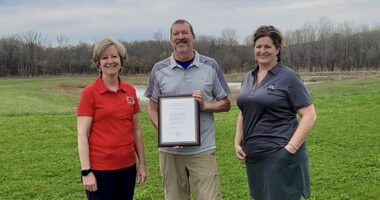This week, the U.S. Environmental Protection Agency (EPA) and Ohio EPA announced that the Columbus area, including Delaware County, is the first non-attainment area in the nation to meet the most recent federal air quality standard for ozone. Recent air monitoring data show the Columbus area now meets the National Ambient Air Quality Standard (NAAQS) for ground-level ozone in addition to all other federal air quality standards set to protect public health.
Now that Columbus has been redesignated, businesses will face fewer air permitting restrictions paving the way for infrastructure investment and economic development that will create jobs.
EPA Regional Administrator Cathy Stepp and Ohio EPA Director Laurie A. Stevenson celebrated this clean air victory today on Ohio EPA’s green roof joined by Columbus Sustainability Assistant Director Alana Shockey and Director of Planning and Sustainability for the Mid-Ohio Regional Planning Commission Kerstin Carr.
“Today’s announcement is tremendous news for the people of the Columbus area and means cleaner air, improved health outcomes, and greater economic opportunity,” said EPA Administrator Andrew Wheeler. “EPA is working closely with the states to help areas like Columbus, which contains Opportunity Zones, reach air quality attainment and breathe new life into their local economies.”
“Today is a very good day for everyone who lives and breathes in the greater Columbus area,” said EPA Region 5 Administrator Cathy Stepp. “The Columbus success story is the direct result of the cooperative partnership between the U.S. EPA, the State of Ohio, the city, local government entities and industry to improve air quality which in turn spurs economic development and revitalization.”
“U.S. EPA’s recognition that the air quality in the Columbus metropolitan area meets the most recent national ozone standard reflects continuing progress in efforts to improve air quality and the quality of life for Ohio residents,” said Ohio EPA Director Laurie A. Stevenson.
The Columbus area was designated in 2018 as a marginal nonattainment area for the 2015 ozone NAAQS based on a multifactor analysis, including air-quality monitoring data. Several federal regulations pertaining to fuel standards and motor vehicle emission standards decreased emissions to help achieve the standard in the Columbus area, which includes Delaware, Fairfield, Franklin, and Licking Counties.
Three years of recent monitoring data show the Columbus area met the 2015 National Ambient Air Quality Standard for ozone. After a public comment process, EPA formally redesignated the Columbus area to attainment and approved Ohio’s plan to ensure that the area will continue to meet the ozone standard. The redesignation was published in the Federal Register today. The Columbus area was already in attainment for all other air pollutants regulated under NAAQS.
Nationally, the concentration of ground level ozone has decreased 17% from 2000 to 2017. All other air pollutants regulated under NAAQS – carbon monoxide, lead, nitrogen dioxide, particulate matter and sulfur dioxide – have also significantly decreased thanks to the various air quality management and control strategies developed and implemented at the local, state, regional, and national level.
Ground level ozone is not emitted directly into the air but is formed when nitrogen oxides (NOx) and volatile organic compounds (VOCs) react in the presence of sunlight. Emissions from industrial facilities and electric utilities, motor vehicle exhaust, gasoline vapors, and chemical solvents are some of the major sources of NOx and VOCs. Breathing ozone can trigger a variety of health problems including chest pain, coughing, throat irritation and congestion. It can worsen bronchitis, emphysema and asthma. Ground level ozone also can reduce lung function and inflame the linings of the lungs. Children are at increased risk from exposure to ozone because their lungs are still developing.
The Columbus area contains multiple census tracts designated as federal Opportunity Zones. An Opportunity Zone is an economically-distressed community where new investment, under certain conditions, may be eligible for preferential tax treatment through the Tax Cuts and Jobs Act of 2017. When possible, EPA is working to target and focus its efforts on Opportunity Zones.









